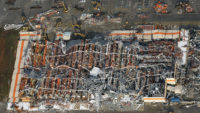Disasters
Tornado Resilience Included in 2024 International Building Code for First Time
New section on tornado loads applies to critical structures such as schools, hospitals

A neighborhood was destroyed by a tornado that struck Joplin, Mo. 13 years ago.
Photo courtesy of AP Photo/Charlie Riedel, File
Thirteen years after a tornado ripped through Joplin, Mo., killing 161, destroying a large medical center, and leveling schools, houses and businesses, the International Code Council (ICC) has for the first time added a section on tornado resilience to the 2024 version of the International Building Code.
The new provisions in ASCE 7, Chapter 32, Tornado Loads, include requirements for critical structures such as hospitals and schools located in tornado-prone regions primarily east of the Continental Divide to withstand wind speeds that correspond approximately to the most commonly occurring EFO to EF2-rated tornadoes.
“Those requirements apply to certain types of important structures in the community, what the building code identifies as Risk Categories 3 and 4," which includes schools, nursing homes, theaters and essential facilities such as fire and police stations and hospitals, says Marc Levitan, lead research engineer in the National Windstorm Impact Reduction Program for the National Institute of Standards and Technology.
Within two days of the devastating 2011 tornado, the City of Joplin was working with NIST to provide data and other insights to an initial research team of three engineers and one social scientist who were on the ground conducting interviews, looking at mobile radar data, studying building failures, and evaluating design documents that showed that none of the city's buildings had been designed specifically for tornadoes.
Joplin, which saw more than 7,400 residences damaged by the tornado, about 40% of which were completely destroyed, moved quickly to adopt more stringent requirements for single-family homes, but it has not changed its requirements for Risk 3 and 4 category commercial buildings.
Communities are not required to follow the IBC’s minimum recommendations for designing safe structures, but the ICC is widely used to create local building codes.
“We felt that the standards in the 2006 IBC code were sufficient,” says Bryan Wicklund, chief building official for Joplin. “Any commercial building built under the 2006 code held up as well as could be expected under 250 mph winds.”
Designing for Tornado Winds
To come up with recommendations on how to design more tornado-resistant buildings, NIST researchers also used wind tunnels, studied historical data and examined debris to learn how tornadic winds push and pull buildings.
“Tornadic winds are very different from straight line winds,” explains Levitan, who was honored in 2021 as an ENR Newsmaker for his his research into tornado wind damage to structures. “Tornadic winds have strong updrafts so the air gets sucked in along the ground surface and then swirls and rotates. It turns the corner and you get these strong updrafts that accentuate the uplift on the roof. You don’t get those strong updrafts near the ground surface in other storms.”
While buildings are usually designed to keep the roof from falling down, engineers designing for tornadoes need to also keep the roof from peeling off, he says.
The new provision contains instructions for structural engineers to learn what tornado intensity they need to prepare for in their area and what pressures those tornadic winds will have on their buildings. It details procedures for topics such as determining design for tornado loads, and selecting the types of building enclosures and windows needed to better withstand tornadoes, along with maps of tornado-prone areas.
Under the code addition, NIST notes that a new hospital facility being built in Dallas, Texas, with a footprint of 1 million sq ft would need to withstand tornado wind speeds of 124 mph. Without the new tornado code, the same hospital would only have to be built for 117 mph straight-line winds.
“It may seem like a small difference, but wind pressures are a function of the square of the speed,” NIST states. “Combined with other factors such as increased roof uplift, tornado loads on some elements of a building can increase by a factor of two or more compared to wind loads. Once they use the code to calculate the wind loads, it’s up to the engineers to adjust their design to meet the increased requirement.”
Levitan says solutions for increasing tornado resistance may include using a thicker roof deck, larger roof beam sizes, and more connectors or anchorage.
Although NIST does not track state and municipal code adoptions, Levitan says the tornado load provisions have already been adopted in the state of Florida and the city of Houston building codes.
“More commonly, states, counties and cities will end up with the tornado load provisions as they adopt the 2024 IBC, which incorporates the ASCE 7 tornado loads by reference,” Levitan says.
The code addition was based on proposals from the American Society of Civil Engineers (ASCE), and the Federal Emergency Management Association (FEMA), along with NIST.
“As severe weather threats continue to increase in frequency and severity, it’s critical to keep building codes continuously updated to reflect the latest research in building science and weather science – that’s how we save lives and preserve communities,” says Dane Rankin, chief structural engineer for the ICC.
Noting that most of the commercial buildings that were damaged in the tornado were older buildings. including St. John’s Medical Center, a 10-story building that had to be completely rebuilt, Wicklund says "everybody has a vested interest in building codes. But you have to keep in mind what’s feasible.”




